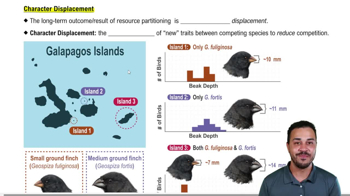Explain why mammals would not be able to produce concentrated urine if their nephrons lacked loops of Henle.
Table of contents
- 1. Introduction to Biology2h 42m
- 2. Chemistry3h 40m
- 3. Water1h 26m
- 4. Biomolecules2h 23m
- 5. Cell Components2h 26m
- 6. The Membrane2h 31m
- 7. Energy and Metabolism2h 0m
- 8. Respiration2h 40m
- 9. Photosynthesis2h 49m
- 10. Cell Signaling59m
- 11. Cell Division2h 47m
- 12. Meiosis2h 0m
- 13. Mendelian Genetics4h 44m
- Introduction to Mendel's Experiments7m
- Genotype vs. Phenotype17m
- Punnett Squares13m
- Mendel's Experiments26m
- Mendel's Laws18m
- Monohybrid Crosses19m
- Test Crosses14m
- Dihybrid Crosses20m
- Punnett Square Probability26m
- Incomplete Dominance vs. Codominance20m
- Epistasis7m
- Non-Mendelian Genetics12m
- Pedigrees6m
- Autosomal Inheritance21m
- Sex-Linked Inheritance43m
- X-Inactivation9m
- 14. DNA Synthesis2h 27m
- 15. Gene Expression3h 20m
- 16. Regulation of Expression3h 31m
- Introduction to Regulation of Gene Expression13m
- Prokaryotic Gene Regulation via Operons27m
- The Lac Operon21m
- Glucose's Impact on Lac Operon25m
- The Trp Operon20m
- Review of the Lac Operon & Trp Operon11m
- Introduction to Eukaryotic Gene Regulation9m
- Eukaryotic Chromatin Modifications16m
- Eukaryotic Transcriptional Control22m
- Eukaryotic Post-Transcriptional Regulation28m
- Eukaryotic Post-Translational Regulation13m
- 17. Viruses37m
- 18. Biotechnology2h 58m
- 19. Genomics17m
- 20. Development1h 5m
- 21. Evolution3h 1m
- 22. Evolution of Populations3h 53m
- 23. Speciation1h 37m
- 24. History of Life on Earth2h 6m
- 25. Phylogeny2h 31m
- 26. Prokaryotes4h 59m
- 27. Protists1h 12m
- 28. Plants1h 22m
- 29. Fungi36m
- 30. Overview of Animals34m
- 31. Invertebrates1h 2m
- 32. Vertebrates50m
- 33. Plant Anatomy1h 3m
- 34. Vascular Plant Transport1h 2m
- 35. Soil37m
- 36. Plant Reproduction47m
- 37. Plant Sensation and Response1h 9m
- 38. Animal Form and Function1h 19m
- 39. Digestive System1h 10m
- 40. Circulatory System1h 49m
- 41. Immune System1h 12m
- 42. Osmoregulation and Excretion50m
- 43. Endocrine System1h 4m
- 44. Animal Reproduction1h 2m
- 45. Nervous System1h 55m
- 46. Sensory Systems46m
- 47. Muscle Systems23m
- 48. Ecology3h 11m
- Introduction to Ecology20m
- Biogeography14m
- Earth's Climate Patterns50m
- Introduction to Terrestrial Biomes10m
- Terrestrial Biomes: Near Equator13m
- Terrestrial Biomes: Temperate Regions10m
- Terrestrial Biomes: Northern Regions15m
- Introduction to Aquatic Biomes27m
- Freshwater Aquatic Biomes14m
- Marine Aquatic Biomes13m
- 49. Animal Behavior28m
- 50. Population Ecology3h 41m
- Introduction to Population Ecology28m
- Population Sampling Methods23m
- Life History12m
- Population Demography17m
- Factors Limiting Population Growth14m
- Introduction to Population Growth Models22m
- Linear Population Growth6m
- Exponential Population Growth29m
- Logistic Population Growth32m
- r/K Selection10m
- The Human Population22m
- 51. Community Ecology2h 46m
- Introduction to Community Ecology2m
- Introduction to Community Interactions9m
- Community Interactions: Competition (-/-)38m
- Community Interactions: Exploitation (+/-)23m
- Community Interactions: Mutualism (+/+) & Commensalism (+/0)9m
- Community Structure35m
- Community Dynamics26m
- Geographic Impact on Communities21m
- 52. Ecosystems2h 36m
- 53. Conservation Biology24m
42. Osmoregulation and Excretion
Osmoregulation and Excretion
Problem 10
Textbook Question
To test the hypothesis that mussels are osmoconformers, researchers exposed mussels to water of varying osmolarities and then drew hemolymph samples from the mussels. Graph the data provided here. Put the independent variable on the x-axis and the dependent variable on the y-axis.
Is the researchers' hypothesis supported by the data? Explain.

 Verified step by step guidance
Verified step by step guidance1
Identify the independent and dependent variables from the data table. The independent variable is the water osmolarity (milliosmol/L), and the dependent variable is the hemolymph osmolarity (milliosmol/L).
Create a graph with the x-axis representing the independent variable (water osmolarity) and the y-axis representing the dependent variable (hemolymph osmolarity).
Plot the data points on the graph using the values from the table: (250, 261), (500, 503), (750, 746), and (1000, 992).
Draw a line or curve that best fits the plotted data points to visualize the relationship between water osmolarity and hemolymph osmolarity.
Analyze the graph to determine if the hemolymph osmolarity closely follows the water osmolarity, indicating that mussels are osmoconformers. If the hemolymph osmolarity changes in direct proportion to the water osmolarity, the hypothesis is supported.
 Verified video answer for a similar problem:
Verified video answer for a similar problem:This video solution was recommended by our tutors as helpful for the problem above
Video duration:
1mPlay a video:
Was this helpful?
Key Concepts
Here are the essential concepts you must grasp in order to answer the question correctly.
Osmoconformers
Osmoconformers are organisms that maintain an internal osmotic environment that is isotonic to their external environment. This means that their body fluids have the same osmolarity as the surrounding water, allowing them to avoid the energetic costs associated with osmoregulation. In the case of mussels, if they are osmoconformers, their hemolymph osmolarity should closely match the osmolarity of the surrounding water.
Recommended video:
Guided course

Osmosis and Osmolarity
Osmolarity
Osmolarity is a measure of the concentration of solute particles in a solution, expressed in milliosmoles per liter (mOsm/L). It is crucial for understanding how organisms interact with their environment, particularly in terms of water movement across cell membranes. In this experiment, the osmolarity of both the water and the hemolymph is measured to determine if the mussels can conform to the osmotic conditions of their surroundings.
Recommended video:
Guided course

Osmosis and Osmolarity
Graphing Data
Graphing data is a fundamental skill in biology that allows researchers to visualize relationships between variables. In this case, the independent variable (water osmolarity) is plotted on the x-axis, while the dependent variable (hemolymph osmolarity) is on the y-axis. Analyzing the resulting graph helps determine if the mussels' hemolymph osmolarity changes in response to varying water osmolarity, thus supporting or refuting the hypothesis.
Recommended video:
Guided course

Character Displacement

 7:16m
7:16mWatch next
Master Osmoregulation and Nitrogenous Waste with a bite sized video explanation from Jason
Start learningRelated Videos
Related Practice
Textbook Question
906
views
